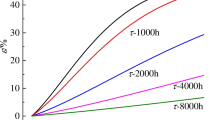Abstract
A fractional plasticity model for geomaterials is proposed by using the fractional derivative. Due to the integral definition of the fractional derivative, the range of load memory for calculating the flow direction may influence the subsequent model performance. Therefore, an investigation on the memory dependence of the model was conducted. It was found that the load memory affected the stress–dilatancy behavior of the geomaterial. Due to the loss of memory from zero- to confining-stress states, slightly higher strain is reported, whereas an insignificant difference in the predicted deviator stress is observed. Thus, for engineering applications, starting the memory from the zero-stress state, which avoids mathematical complexity, is suggested.





Similar content being viewed by others
References
Khalili, N., Habte, M.A., Valliappan, S.: A bounding surface plasticity model for cyclic loading of granular soils. Int. J. Numer. Methods Eng. 63, 1939–1960 (2005)
Liu, H.B., Zou, D.G., Liu, J.M.: Constitutive modeling of dense gravelly soils subjected to cyclic loading. Int. J. Numer. Anal. Methods Geomech. 38, 1503–1518 (2014)
Kan, M.E., Taiebat, H.A.: A bounding surface plasticity model for highly crushable granular materials. Soils Found. 54, 1188–1201 (2014)
Xiao, Y., Liu, H.: Elastoplastic constitutive model for rockfill materials considering particle breakage. Int. J. Geomech. 17, 04016041 (2016)
Sun, Y., Indraratna, B., Carter, J.P., et al.: Application of fractional calculus in modelling ballast deformation under cyclic loading. Comput. Geotech. 82, 16–30 (2017)
Liao, M., Lai, Y., Liu, E., et al.: A fractional order creep constitutive model of warm frozen silt. Acta Geotech. 12, 377–389 (2016)
Xu, Z., Chen, W.: A fractional-order model on new experiments of linear viscoelastic creep of Hami Melon. Comput. Math. Appl. 66, 677–681 (2013)
Zhu, S., Cai, C., Spanos, P.D.: A nonlinear and fractional derivative viscoelastic model for rail pads in the dynamic analysis of coupled vehicle-slab track systems. J. Sound Vib. 335, 304–320 (2015)
Yang, X., Chen, W., Sun, H.: Fractional time-dependent apparent viscosity model for semisolid foodstuffs. Mech. Time-Depend. Mater. (2017). https://doi.org/10.1007/s11043-017-9366-8
Sun, Y., Xiao, Y., Zheng, C., et al.: Modelling long-term deformation of granular soils incorporating the concept of fractional calculus. Acta. Mech. Sin. 32, 112–124 (2016)
Zhou, H.W., Wang, C.P., Mishnaevsky, L., et al.: A fractional derivative approach to full creep regions in salt rock. Mech. Time-Depend. Mater. 17, 413–425 (2013)
Zhou, H.W., Wang, C.P., Han, B.B., et al.: A creep constitutive model for salt rock based on fractional derivatives. Int. J. Rock Mech. Min. Sci. 48, 116–121 (2011)
Sumelka, W.: Fractional viscoplasticity. Mech. Res. Commun. 56, 31–36 (2014)
Sun, Y., Shen, Y.: Constitutive model of granular soils using fractional order plastic flow rule. Int. J. Geomech. 17, 04017025 (2017)
Sun, Y., Xiao, Y.: Fractional order plasticity model for granular soils subjected to monotonic triaxial compression. Int. J. Solids Struct. 118–119, 224–234 (2017)
Roscoe, K.H., Burland, J.B.: On the generalised stress–strain behaviour of ’wet’ clay. In: Heyman, J., Leckie, F.A. (eds.) Engineering Plasticity. Cambridge University Press, Cambridge (1968)
Been, K., Jefferies, M.G.: A state parameter for sands. Géotechnique 22, 99–112 (1985)
Li, X., Wang, Y.: Linear representation of steady-state line for sand. J. Geotech. Geoenviron. Eng. 124, 1215–1217 (1998)
Ishihara, K., Tatsuoka, F., Yasuda, S.: Undrained deformation and liquefaction of sand under cyclic stresses. Soils Found. 15, 29–44 (1975)
Aursudkij, B., McDowell, G.R., Collop, A.C.: Cyclic loading of railway ballast under triaxial conditions and in a railway test facility. Granul. Matter 11, 391–401 (2009)
Acknowledgements
Financial support provided by the National Natural Science Foundation of China (Grant 41630638), the Priority Academic Program Development of Jiangsu Higher Education Institutions, and the Fundamental Research Funds for the Central Universities (Grant 2017B05214) are appreciated.
Author information
Authors and Affiliations
Corresponding author
Rights and permissions
About this article
Cite this article
Sun, Y., Gao, Y. & Song, S. Effect of integrating memory on the performance of the fractional plasticity model for geomaterials. Acta Mech. Sin. 34, 896–901 (2018). https://doi.org/10.1007/s10409-018-0777-9
Received:
Revised:
Accepted:
Published:
Issue Date:
DOI: https://doi.org/10.1007/s10409-018-0777-9




